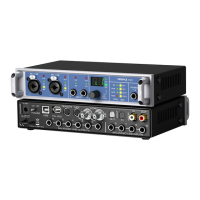
Do you have a question about the RME Audio Fireface UCX and is the answer not in the manual?
| Number of Inputs | 12 |
|---|---|
| Number of Outputs | 12 |
| AD/DA Conversion | 24-bit / 192 kHz |
| Mic Preamps | 4 |
| Phantom Power | Yes |
| MIDI I/O | Yes |
| Power Supply | External power supply |
| Analog Inputs | 8 |
| Analog Outputs | 8 |
| Headphone Output | 1 |
| USB | USB 2.0 |
| Word Clock | Yes |
| TotalMix FX | Yes |
| DURec | No |
| Audio Interface Type | USB |
| Digital Inputs | ADAT, SPDIF |
| Digital Outputs | ADAT, SPDIF |
Overview of the Fireface UCX, its capabilities, and package contents.
Details the necessary hardware and software for operating the Fireface UCX.
Guides new users through initial setup, connections, and basic operation.
Step-by-step instructions for physically connecting the Fireface UCX via USB or FireWire.
Covers driver installation, updates, and firmware management for Windows.
Explains how to use the Settings dialog for latency, sample rate, and digital I/O configuration.
Details general settings like latency, DSP operation, sample rate, and sync behavior.
Discusses playback, recording, and clock synchronization for Windows operation.
Explains how to manage clock sources and ensure synchronization between digital devices.
Provides solutions for common problems encountered during setup and operation.
Guides physical connection of the Fireface UCX to a Mac via USB or FireWire.
Covers driver installation, updates, and firmware management for macOS.
Explains macOS settings for latency, sample rate, and digital I/O configuration.
Details general settings like latency, sample rate, and sync behavior in macOS.
Addresses common questions and issues specific to using the Fireface UCX on macOS.
Explains channel availability and limitations within macOS Core Audio.
Describes the rear and front analog input connectors, levels, and impedance.
Explains the two combo jacks for mic/line inputs, including gain and phantom power.
Explains how to connect via ADAT, SPDIF, and AES/EBU formats.
Covers word clock input/output, synchronization, and cabling for digital clocking.
Explains the setup and functionality of word clock connections for system synchronization.
Introduces the TotalMix FX mixer, its capabilities, and typical applications.
Explains the visual layout of TotalMix FX, including hardware inputs, playback, and outputs.
Details the controls and functions available for individual channels within TotalMix FX.
Explains the features of the 3-band parametric equalizer and low-cut filter.
Describes the Compressor, Expander, and Auto Level functions for dynamic processing.
Covers global controls like DSP meter, undo/redo, and mute/solo functions.
Configures mixer-specific options like Talkback, Listenback, and MIDI remote control.
Configuration for MIDI remote control via CC or Mackie Control protocols.
Details keyboard shortcuts and mouse combinations for efficient TotalMix FX operation.
Describes the alternative matrix view for routing and assigning signals.
Provides helpful techniques for using TotalMix FX, including ASIO monitoring and loopback.
Details how to use loopback for recording submixes or software playback.
Explains how to control TotalMix FX remotely using MIDI devices and protocols.
Provides detailed technical data for analog, MIDI, digital, and general aspects of the Fireface UCX.
Comprehensive specifications for all analog inputs and outputs, including levels and impedance.
Technical details for digital interfaces like ADAT, SPDIF, AES/EBU, and word clock.
Explains underlying technologies such as clock synchronization, latency, and USB/FireWire audio.
Discusses latency figures, monitoring concepts, and buffer size settings.
Describes the specifics of USB audio transmission and potential issues.
Includes a block diagram and connector pinouts for the Fireface UCX.
Illustrates the pin assignments for analog input and output connectors.
Lists optional accessories available for the Fireface UCX.
Information regarding the product warranty and service procedures.
Contains driver versions, trademarks, and copyright information.
Details compliance with electromagnetic compatibility and safety directives.
